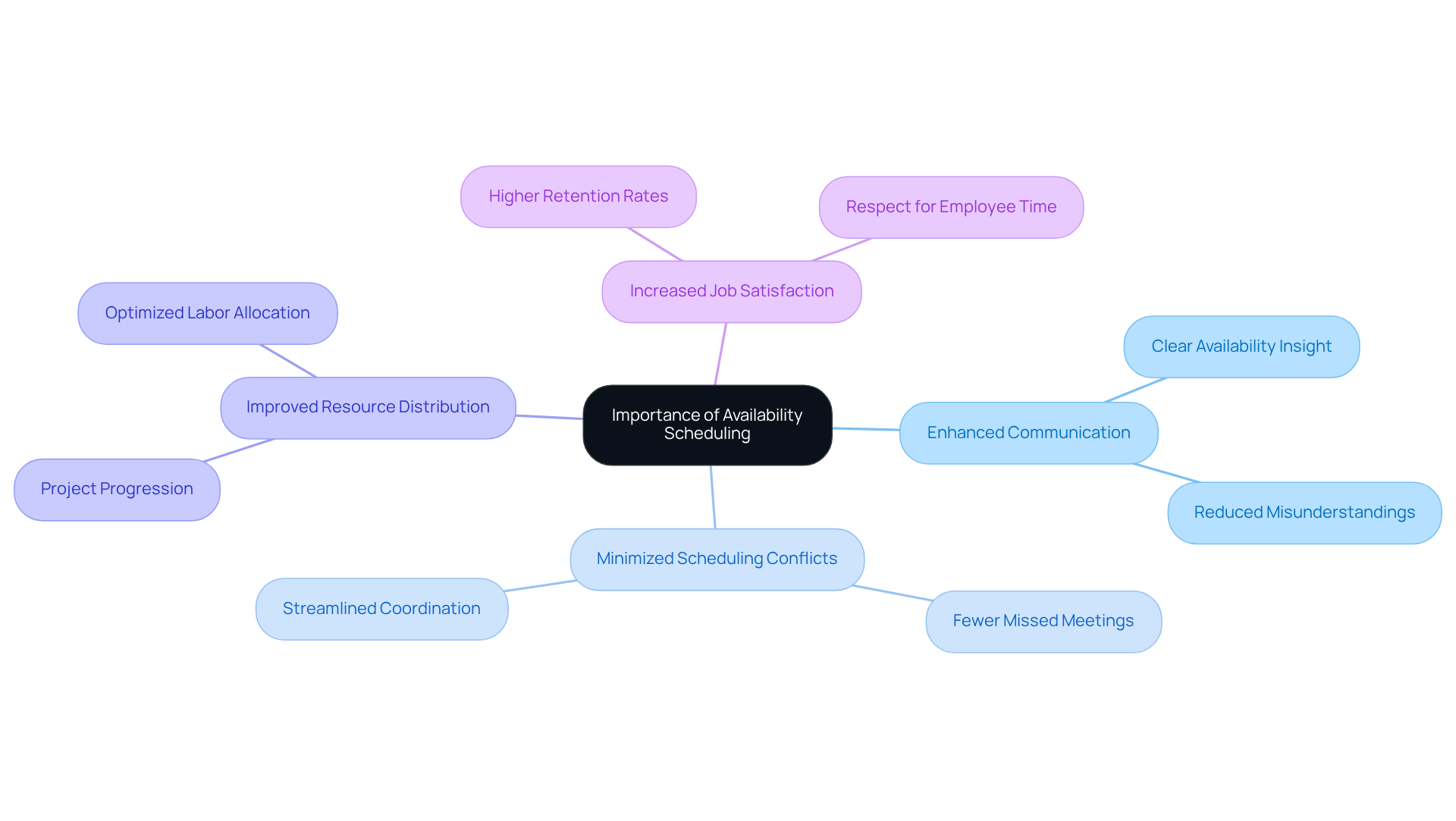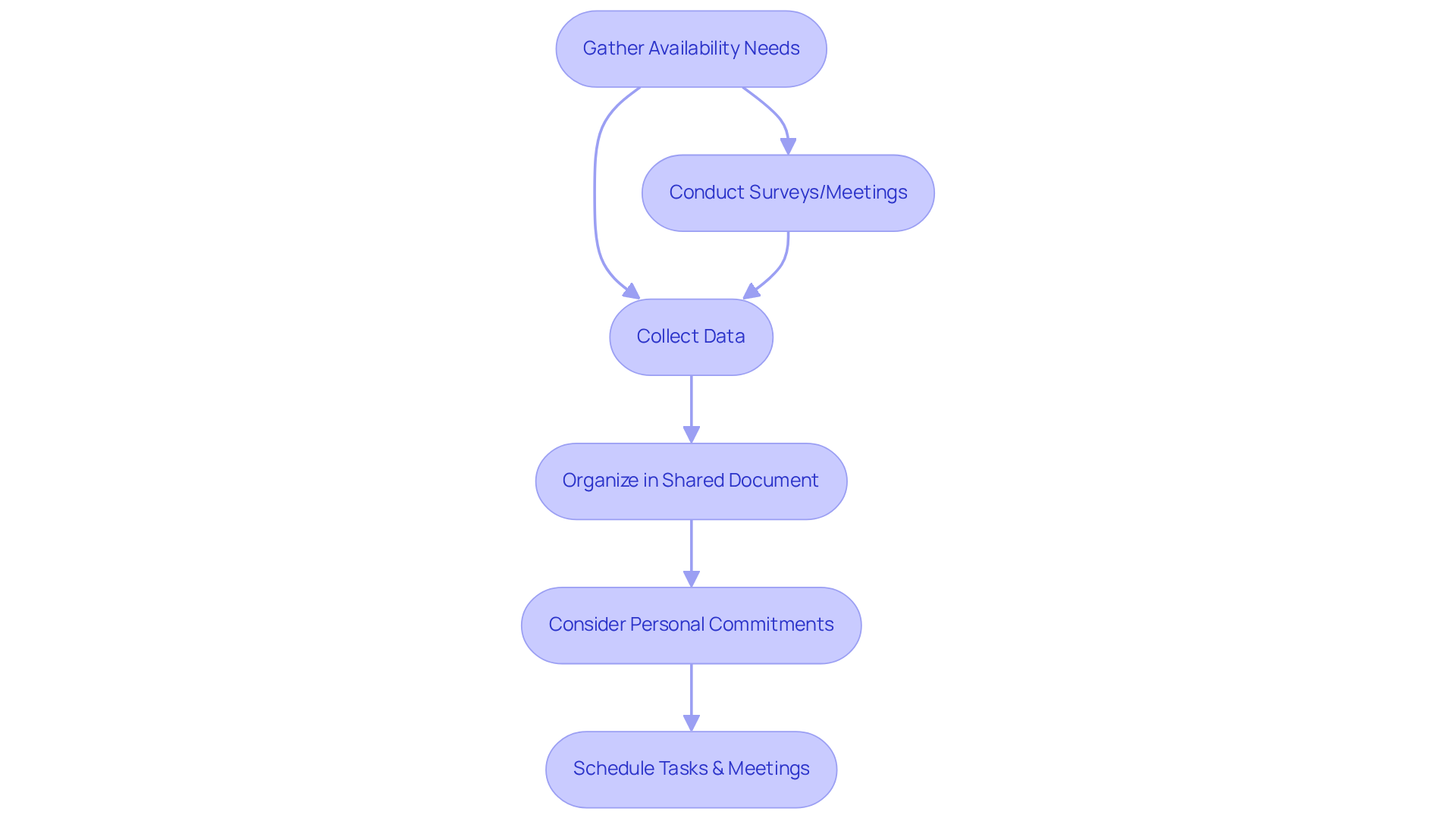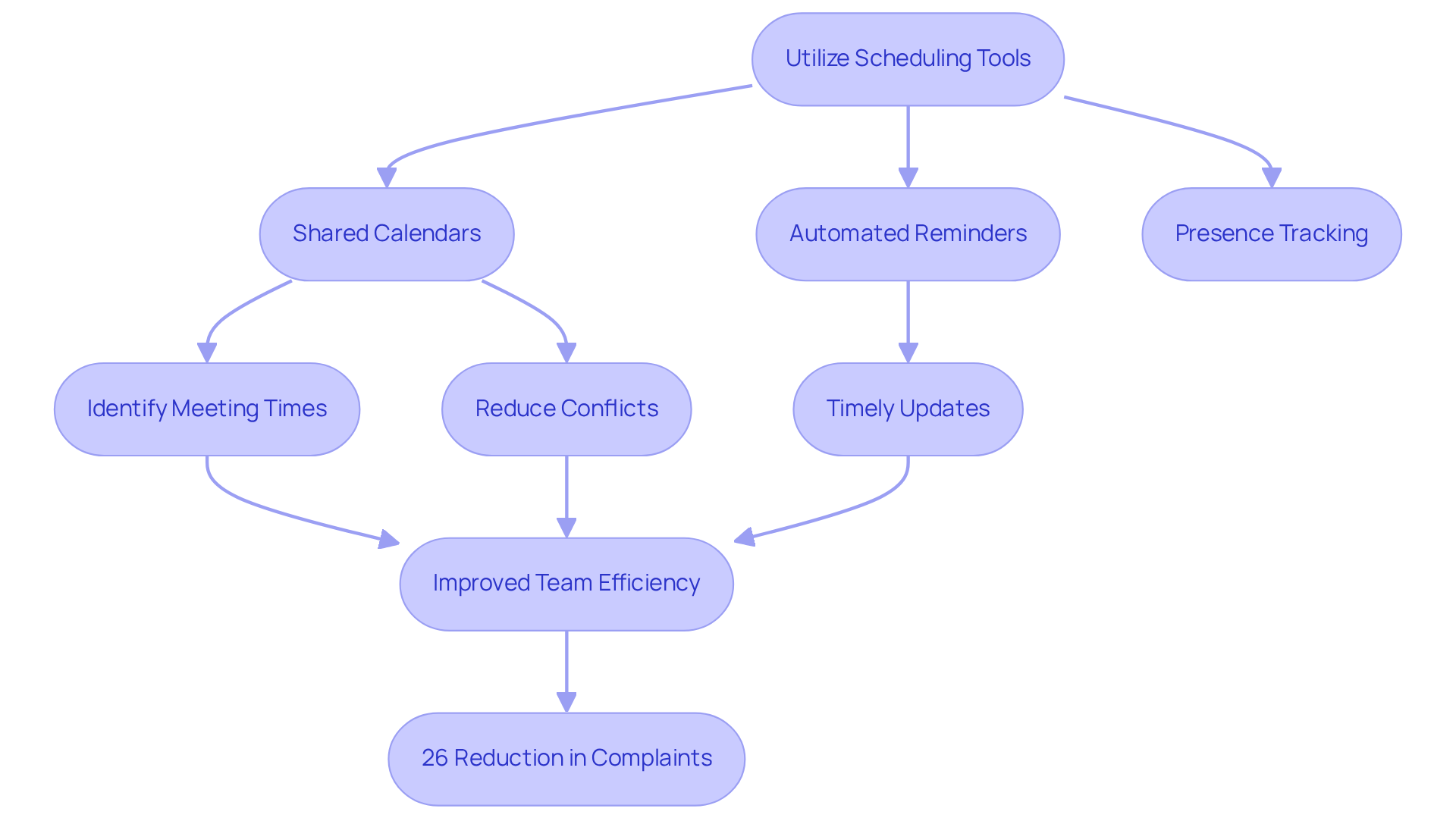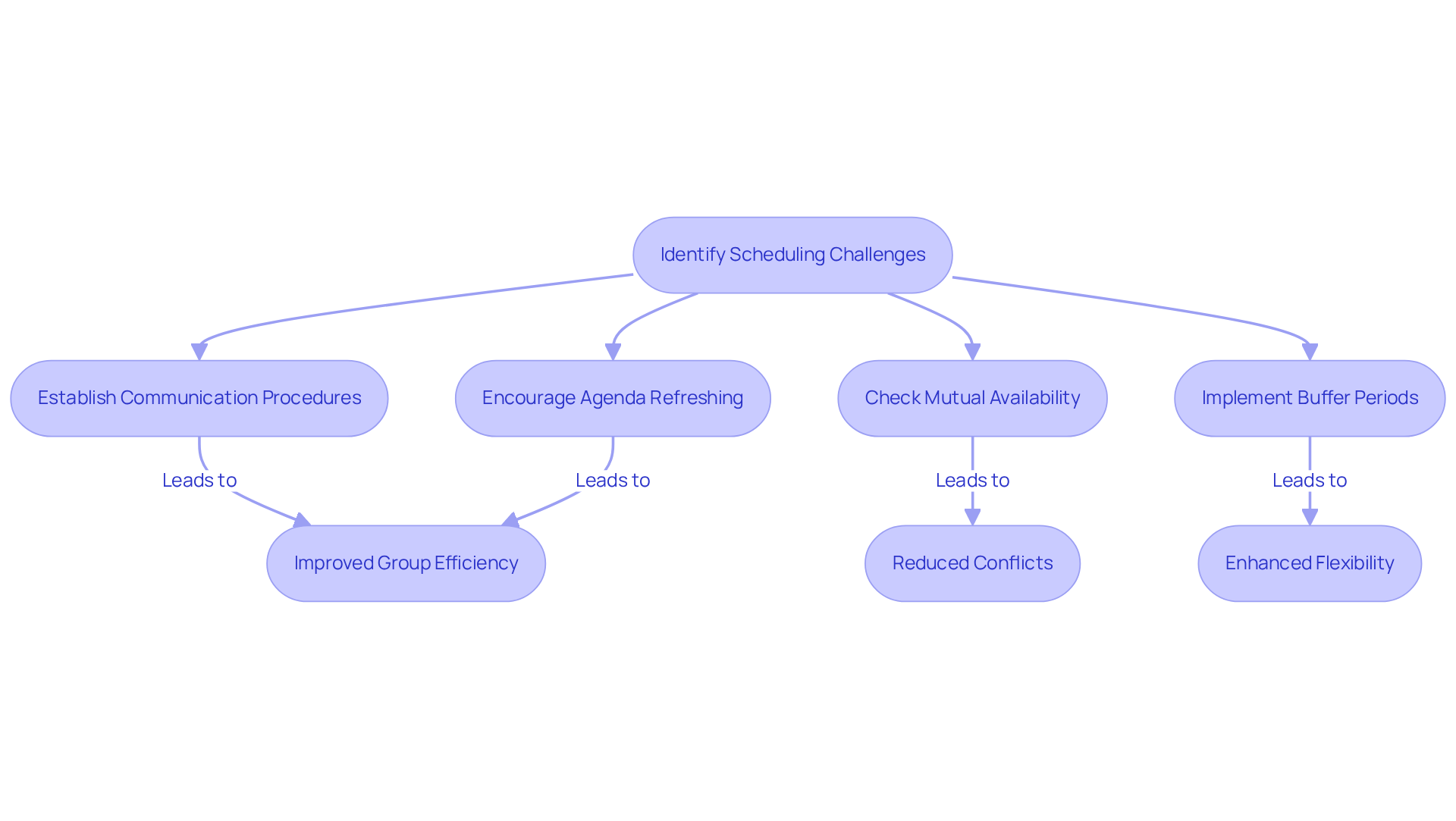Master Your Availability Schedule for Optimal Team Efficiency

Overview
Mastering your availability schedule is crucial for optimizing team efficiency. It enhances communication, minimizes scheduling conflicts, and improves overall productivity. A well-organized availability schedule fosters respect for employees’ time and commitments, ultimately leading to higher job satisfaction and retention rates. Evidence supports that improved coordination is achieved through the use of planning tools and transparent communication practices.
Addressing the problem of communication inefficiencies is essential for any organization. By implementing effective scheduling strategies, teams can significantly reduce misunderstandings and overlapping commitments. The integration of planning tools not only streamlines processes but also cultivates a culture of respect and accountability among team members.
The unique features of a well-structured availability schedule are manifold. They include enhanced visibility into team members’ commitments, which allows for better resource allocation and project management. As teams adopt transparent communication practices, they foster an environment where everyone feels valued and understood. This approach not only boosts morale but also drives productivity to new heights.
In conclusion, exploring and implementing a robust availability scheduling system is imperative for any organization aiming to enhance operational efficiency. The benefits are clear: improved communication, reduced conflicts, and heightened employee satisfaction. Embrace the opportunity to transform your team’s dynamics and drive success.
Introduction
Effective team management hinges on one critical element: availability scheduling. When team members have a clear understanding of each other’s schedules, it not only enhances communication but also significantly boosts productivity and morale. This article delves into the art of mastering availability schedules, exploring how strategic planning can transform group dynamics and operational efficiency.
With nearly 70% of teams facing common scheduling challenges, organizations must confront the question: how can they overcome these obstacles to foster a more cohesive and efficient work environment? By addressing these scheduling inefficiencies, teams can unlock their full potential, leading to improved collaboration and success.
Understand the Importance of Availability Scheduling
Availability planning stands as a cornerstone of effective group management, significantly influencing both productivity and morale. When team members are aware of each other’s availability schedule, it fosters enhanced communication and minimizes the likelihood of scheduling conflicts. This clarity aids in orchestrating meetings, distributing resources, and ensuring seamless project progression. Moreover, a meticulously organized work schedule not only respects employees’ time and commitments but also elevates job satisfaction, ultimately leading to improved retention rates.
Consider a scenario where team members have overlapping commitments; without transparent insight into each individual’s availability schedule, critical meetings may be missed, resulting in project delays and heightened frustration. Thus, mastering resource allocation transcends the mere act of filling time slots; it is fundamentally about enhancing group dynamics and operational effectiveness. Embrace the power of strategic availability planning to transform your team’s performance and cohesion.

Define Your Team’s Availability Needs
To effectively manage your group’s availability schedule, it is essential to begin by gathering information on each member’s preferred working hours, days off, and any other commitments that may influence their availability. Conducting surveys or one-on-one meetings to collect this data will provide a comprehensive understanding of your group’s needs. Once you have this information, organize it into a shared document or planning tool, which will serve as a crucial reference point for the availability schedule, scheduling meetings, and assigning tasks. For instance, if a team member prefers to work late afternoons, ensure that their tasks and meetings are scheduled accordingly.
Additionally, consider any upcoming vacations or personal commitments that may impact your availability schedule. By clearly outlining these needs, you can establish a more efficient and respectful planning process that accommodates everyone involved. Statistics reveal that:
- 43% of employees wish to adjust their working hours to improve work-life balance
- 69% of employees regard work-life balance as ‘very important’
- 40% of individual contributors are at risk of burnout
Understanding personal commitments in planning is vital for preserving group morale and productivity.
Integrating effective group presence surveys, similar to those utilized by leading companies, can offer valuable insights into your group’s preferences and significantly enhance overall planning efficiency.

Utilize Scheduling Tools for Streamlined Coordination
To enhance group coordination, it is essential to leverage planning tools equipped with features such as shared calendars, automated reminders, and presence tracking. Tools like Google Calendar, Microsoft Teams, and dedicated planning software provide a clear representation of group presence, facilitating the identification of suitable meeting times. For instance, a collaborative calendar allows group members to indicate their availability schedule, thereby simplifying the planning process and reducing conflicts. Moreover, selecting tools that integrate seamlessly with existing communication platforms guarantees timely updates and notifications. By implementing these solutions, organizations can significantly decrease the time spent on planning, allowing teams to concentrate on their core responsibilities and improve overall efficiency.
Importantly, organizations that utilize shared calendars observe a marked enhancement in team coordination, with data indicating that an effective availability schedule and efficient planning tools can lead to a 26% reduction in employee complaints related to scheduling. As Peter Drucker aptly noted, “Nothing is less productive than to make more efficient what should not be done at all.” This underscores the importance of employing the right tools to optimize planning processes. Additionally, the growing trend of online appointment booking highlights the necessity for organizations to adapt to modern practices, ensuring they remain competitive and efficient.

Troubleshoot Common Scheduling Challenges
Scheduling issues present an unavoidable challenge in group dynamics, often stemming from overlapping commitments, last-minute alterations, and miscommunication. Studies indicate that nearly 70% of groups frequently encounter planning issues, significantly hindering productivity. As Peter Drucker aptly stated, “If we can’t manage our time, we can’t manage anything else,” underscoring the critical role of effective time management in alleviating these challenges.
To tackle timing issues, establishing a robust communication procedure that incorporates an availability schedule for informing group members of any changes in attendance is essential. Encourage team members to promptly refresh their agendas and utilize planning tools that align with the availability schedule to automatically send alerts and keep everyone updated.
When disagreements arise, it is imperative to address them swiftly by checking mutual availability schedules and proposing alternative times that accommodate all parties involved. Dale Carnegie’s approach emphasizes tackling the most challenging tasks first, a strategy that can be applied to manage timing issues by prioritizing communication and adaptability. Additionally, implementing a buffer period between meetings can effectively address unexpected changes, allowing for flexibility without disrupting the overall schedule.
Organizations that have adopted transparent communication guidelines for planning—such as an availability schedule for regular check-ins and shared calendars—report a marked improvement in group efficiency and a reduction in conflicts. By proactively managing these challenges, you can streamline the planning process and enhance your team’s productivity. As Zig Ziglar wisely noted, “You can get everything in life you want if you will just help enough other people get what they want,” emphasizing the collaborative effort necessary for effective scheduling.

Conclusion
Mastering the art of availability scheduling is not just beneficial; it is essential for optimizing team efficiency and fostering a productive work environment. Organizations that prioritize clear communication regarding each team member’s availability can significantly reduce scheduling conflicts and enhance collaboration. This strategic approach not only respects individual commitments but also cultivates a culture of accountability and respect. Ultimately, this leads to increased job satisfaction and retention.
Key insights highlight the importance of understanding team members’ availability needs, utilizing effective scheduling tools, and proactively addressing common scheduling challenges. Gathering data on preferred working hours, leveraging shared calendars, and establishing robust communication protocols are crucial steps in creating a seamless scheduling process. By implementing these strategies, teams can mitigate the risks of burnout and improve overall productivity.
Reflecting on the significance of availability scheduling underscores its role as a vital component of team success. Organizations that embrace this practice will enhance their operational efficiency while creating an environment where employees feel valued and respected. By taking action to master availability scheduling, teams can unlock their full potential, leading to better outcomes and a more harmonious workplace culture.
Frequently Asked Questions
What is the significance of availability scheduling in group management?
Availability scheduling is crucial for effective group management as it influences productivity and morale. It enhances communication among team members and minimizes scheduling conflicts.
How does knowing each other’s availability impact team dynamics?
When team members are aware of each other’s availability, it aids in organizing meetings, distributing resources, and ensuring smooth project progression, which ultimately improves team dynamics.
What are the benefits of a well-organized work schedule?
A well-organized work schedule respects employees’ time and commitments, elevates job satisfaction, and can lead to improved retention rates.
What can happen if team members have overlapping commitments without a clear availability schedule?
If team members have overlapping commitments without transparency in availability, critical meetings may be missed, leading to project delays and increased frustration.
What does mastering resource allocation involve?
Mastering resource allocation goes beyond merely filling time slots; it is about enhancing group dynamics and operational effectiveness through strategic availability planning.
